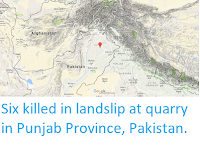An Austrian climber has died and two Britons were injured when their tent was hit by an avalanche on the Ultar Sar Peak in the Hunza Valley in Gilgit-Baltistan Province, Pakistan, on Friday 29 June 2018. The three men have been identified as Christian Huber, who died in the incident, plus Bruce Normand and Timothy Miller, who were rescued by a helicopter from the Pakistan Army and are being treated at a hospital in Islamabad. The avalanche occurred at an altitude of 5.9 km and was caused by a storm, which also hampered the rescue attempt. The helicopter crew have been commended for their actions.
Austrian climber Christian Huber who died in an avalanche on Ultra Sar on 29 June 2018. AP.
Ultra Sar forms part of the Karakorum Mountain Range, which runs through Afghanistan, Pakistan, India, Tajikistan and into China. At 7388 m it is not among the higher mountains in the range, but it is one of the most prominent, rising 5300 m above the floor of the Hunza Valley. As such it is of great interest to climbers, though it is considered an extremely difficult and dangerous ascent, with fifteen failed attempts to climb it and numerous fatalities, during the 1980s and 1990s, before the summit was eventually reached by a Japanese team in 1996.
Ultra Sar, right, foreground, with (rght to left) Bojohagur Duanasir, Hunza, and Bumblimotin behind. Wikimedia Commons.
Avalanches are caused by the mechanical failure of snowpacks;
essentially when the weight of the snow above a certain point exceeds
the carrying capacity of the snow at that point to support its weight.
This can happen for two reasons, because more snow falls upslope,
causing the weight to rise, or because snow begins to melt downslope,
causing the carrying capacity to fall. Avalanches may also be triggered
by other events, such as Earthquakes or rockfalls. Contrary to what is
often seen in films and on television, avalanches are not usually
triggered by loud noises. Because snow forms layers, with each layer
typically occurring due to a different snowfall, and having different
physical properties, multiple avalanches can occur at the same spot,
with the failure of a weaker layer losing to the loss of the snow above
it, but other layers below left in place - to potentially fail later.
Diagrammatic representation of an avalanche, showing how layering of snow contributes to these events. Expedition Earth.
See also...
Follow Sciency Thoughts on Facebook.









